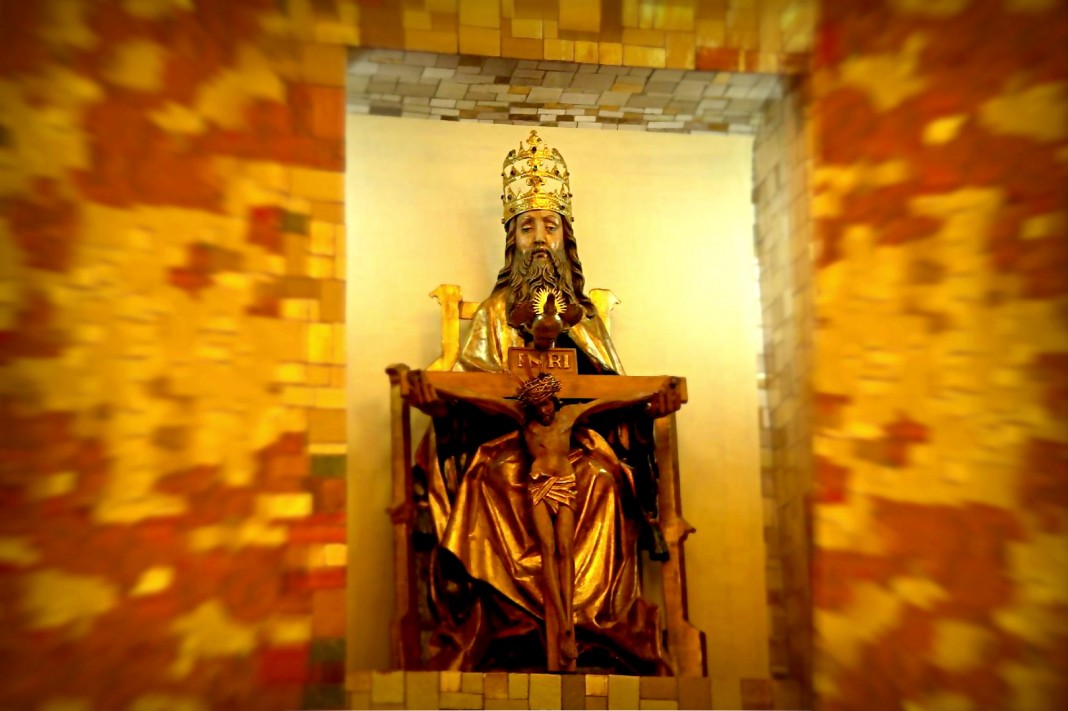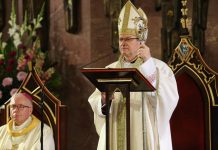At the end of the Mass at Jasna Gora Pope Francis blessed the crown of the Statue of the Holy Trinity (from Prostyn, diocese of Drohiczyn). This is the only shrine of the Holy Trinity in Poland (on the diocesan rights). It has a very rich history.
Prostyń is a small locality in Podlassia beautifully situated on the edge of The Bug River Valley Landscape Park, amidst a picturesque landscape of lakes, meadows and woods. It is about 100 km east of Warsaw, on the borderline of former Mazovia and Podlassia.
Within a short distance from Prostyń, there are some notable sites. Perhaps the most well-known is the former World War II death camp, Treblinka. However, not far away from here there is another important place – Zuzela, the home village of Card. Stefan Wyszyński,s, the Primate of Poland, whose parents, in fact, married in the church of Prostyń.
The Revelations of St. Anne
The sources affirm that St. Anne appeared in Prostyń early in the morning after the Feast of the Holy Trinity in 1510 (27th May). An inhabitant of the village, Małgorzata, wife of Błażej, went out of the house and saw a woman, all dressed in white, standing at the nearby cross. She was disquieted by the thought that she was seeing death, then the stranger said: “Woman, do not be afraid! I am not death, but I am St. Anne […] Go to Prostyński and tell him to dedicate to the Holy Trinity the hill behind the village, where we have been for a long time now […], to build a church there, and to build a chapel in the place of my revelation. As a token of the veracity of my words I am leaving four wreaths on the bench under the cross. Three of them are linked one to another as a sign of the Holy Trinity, and the fourth one is in my memory […].”
Local tradition has also preserved details of a second revelation of St. Anne. According to it, St. Anne, wearing a monastic habit, appeared to a farmer of the village Złotki, asking him to take her to Prostyń. When the Saint sat on the cart, the oxen raced across the marshland. When they fortunately reached their destination, they stopped in front of the hill on which the present church stands. The woman introduced herself: “I am St. Anne. I am going to worship the Holy Trinity.” Having said that, she walked up the hill and, kneeling down, she folded her hands to pray.
Pilgrims and Healings
The moment of the revelations commenced a series of miraculous healings. The parochial archive preserves the Book of Miracles mentioned above, which gives one hundred and nine cases of the restoration to health of people who had been, for example, paralyzed or blind, who suffered from rheumatism, or who could not walk etc. The research carried out in this area demonstrated the conformity of the accounts of the people appearing in the Book of Miracles with other documents of that period.
In the following years the Book of Miracles was not kept, although the successive bishops encouraged everyone to register the healings, so some later accounts have been recorded of people,s restoration to health and the rendering of thanks for received graces. Numerous ex-votos have decorated the sanctuary of Prostyń for centuries and testify to the outpouring of Divine Grace in this holy place.
The Miraculous Statue
It is a Gothic sculpture representing the Holy Trinity. God the Father is sitting on the throne, holding the body of the crucified Jesus Christ. Over the Cross there is a dove – a sign of the Holy Spirit. In this way the mystery of the Holy Trinity has been presented as “the Throne of Grace” (Hebrews 4: 16).
Research has revealed the origins of the Statue – it was made by Veit Stoss or his pupils at the turn of the 15th century to the16th century. Its archetype might be the triptych of Wawel from the Chapel of the Holy Cross.
The sculpture was most probably a donation of Bishop Paweł Aligmunt Holszański, who presented it to Prostyń in connection with the revelations of St. Anne and the creation of the parish in 1511, or in 1513 on the occasion of the arrival of the documents of the Holy See assigning the right to grant indulgences to the new sanctuary.
The statue,s early date is also indicated by the fact that, in the beginning of the 16th century it was referenced, and even mentioned as being miraculous.
The Holy Father John Paul II and Prostyń
In 2003 the sanctuary of Prostyń received from the Polish Pope an unusual gift. The Holy Father John Paul II donated to the hill of Prostyń the chalice he had used during the Holy Mass when he celebrated his 50th anniversary of ordination to the priesthood.
Another expression of the Pope’s great benevolence is a blessing personally signed by John Paul II in which the Holy Father writes: “I cordially impart my Apostolic Blessing to the Parishioners of Prostyń and to the Pilgrims arriving at the Sanctuary of the Holy Trinity and of St. Anne in Prostyń.”
Conclusion
The hill of Prostyń is a place where heaven meets earth, and where man encounters God. According to the archived documents, in the sanctuary of Prostyń many people have received and continue to receive particular graces, including healings, both in spirit and in body.
[source: Parochial Archive of Prostyn]

 English
English







